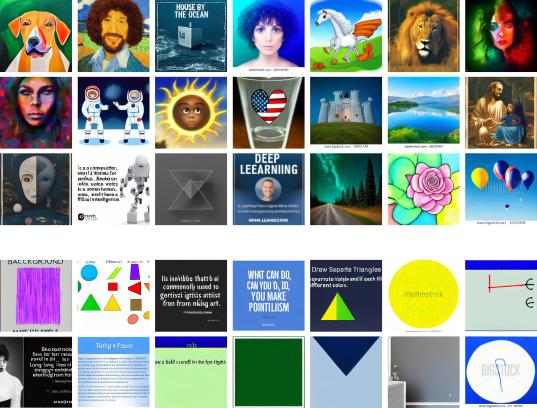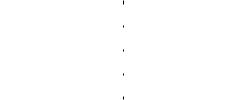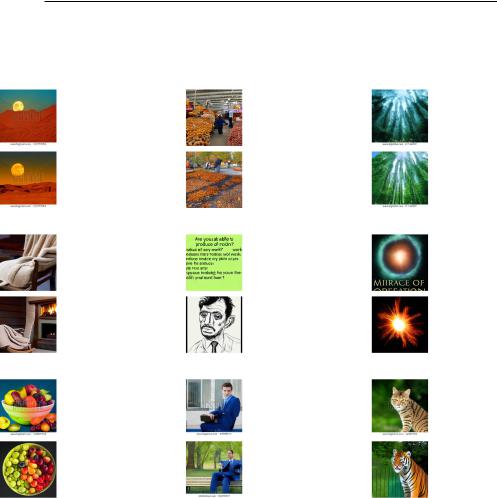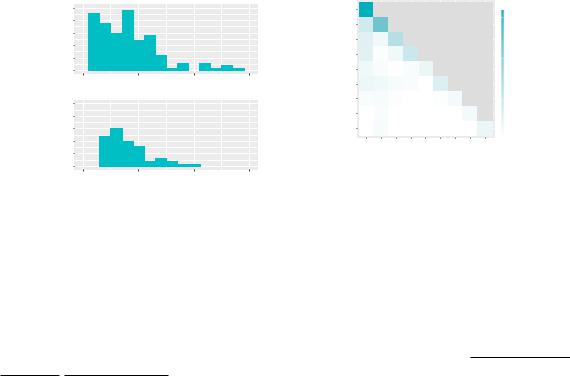
- •1 Introduction
- •2 Related Work
- •2.2 Prompt Engineering for AI Art
- •2.3 Prompt Engineering as a Skill
- •2.4 Prior Work on Applying Skill in Practice
- •3.1 Research Materials
- •3.2 Task Design and Recruitment
- •3.3 Analysis
- •3.4 Results
- •4 Study 1: Understanding Prompt Engineering
- •4.1 Method
- •4.2 Results
- •5 Study 2: Writing Prompts
- •5.1 Method
- •5.2 Results
- •6 Study 3: Improving Prompts
- •6.1 Method
- •6.2 Results
- •7 Discussion
- •7.2 On the Future of Creative Production with Prompt Engineering
- •7.4 Limitations and Future Work
- •8 Conclusion
- •References
- •A Set of images used in Study 1
- •A.1 Images with High Aesthetic Appeal
- •A.2 Images with Low Aesthetic Appeal

17
•Abstract trippy colorful background
•surreal sky castle
•Can you paint me a rendition of the Monalisa?
•Bob Ross, Claude Monet, Vincent Van Gogh
•Are you able to produce any of rodans work.
•what can you do, can you make pointillism artwork?
Besides this sparse — and sometimes accidental — addition of style information, we find that overall, participants did not control the style of their creations. Instead of prompt modifiers, the participants’ artwork styles were mainly determined by the participants’ use of descriptive language.
6STUDY 3: IMPROVING PROMPTS
In a follow-up study, we investigated whether participants could improve their artworks. This study aimed to answer the question of whether prompt engineering is an innate skill that we humans apply intuitively or whether it is an acquired skill that requires expertise and practice (e.g., via learning to write prompts from repeated interactions with the text-to-image generation system) and knowledge of certain keywords and key phrases (prompt modifiers), as discussed in Section 2.2.2 and Section 5.2.3. We hypothesize that if prompt engineering is a learned skill, participants will not be able to significantly improve their artworks after only one iteration.
6.1Method
6.1.1 Study design. We invited the same participants who participated in Study 2 to review images generated from their own prompts. Participants were then asked to improve their three prompts. To this end, we designed a task that introduced the participant to the study’s purpose, using the same instructions as in the previous study. We additionally highlighted that if the images presented to the participant did not look like artworks, the prompt should be adjusted. Like in the previous study, we avoided to mention that prompt modifiers could be used to achieve this aim.
Participants were given five images for each of the three prompts they wrote in Study 2. We used the workerId variable on MTurk to load the participant’s previous prompts and images. Participants were then asked to rewrite and improve their three prompts. The task included two input fields, one pre-filled with their previous prompt and one for optional negative terms. In practice, negative terms are an important part of the toolbox of prompt engineers, primarily used for controlling the subject and quality of the image generation [45]. For example, defining “watermark” and “shutterstock” as negative terms can reduce the occurrence of text and watermarks in the resulting image. Given the task of improving their previously generated artworks, we introduced negative terms as a possible tool for making improvements in Study 3. We studied this by incorporating it into our study design. Participants were introduced to the potentially surprising effects of negative terms with the help of an example. The example explained that adding “zebra” as a negative term to a prompt for a pedestrian crossing could potentially result in an image of a plain road (due to stripes being removed).
For each prompt, we also collected information on whether the images matched the participant’s original expectations (given the previous prompt) and whether the participant thought the prompt needed improvement (both on a Likertscale from 1 – Strongly Disagree to 5 – Strongly Agree). The latter was added to identify cases in which participants thought that no further improvement of the prompt was necessary. We also asked participants to rate their confidence that the new prompt would result in a better artwork (on a Likert scale from 1 – Not At All Confident to 5 – Highly

18 |
Jonas Oppenlaender, Rhema Linder, and Johanna Silvennoinen |
Confident). The task concluded with demographic questions, including the participant’s experience with text-based image generation and interest in viewing and practicing art. The task design was tested and improved in a small-scale pilot study ( = 8; US$1 per task). The payment was set to US$1.75, aiming for an hourly pay of above minimum wage in the United States.
6.1.2 Research materials. In this section, we describe how we selected an image generation system and how we generated images from the participants’ prompts.
System selection. We experimented with different text-to-image generation systems, including CLIP Guided Diffusion (512x512, Secondary Model)6, CLIP Guided Diffusion (HQ 512x512 Uncond)7, DALLE-E mini8, Disco Diffusion 5.3 and 5.49, Latent Diffusion10, and Majesty Diffusion 1.311. In the end, we selected Latent Diffusion for two main reasons. Latent Diffusion is the foundation for many of the community-driven adaptations and modifications. More importantly, the system is deterministic and leads to reproducible outcomes. Consecutive runs with the same seed value will generate the same images. This is a crucial requirement since we aim to compare images in between studies.
Image generation. We generated images for the participants’ prompts with Latent Diffusion using the following configuration settings: text2img-large model (1.4B parameters), seed value 1040790415, eta 1.0, ddim steps 100, and scale 5.0. Even though the system is capable of generating images at higher resolutions, we decided to generate images of 256 × 256 pixels to avoid the quirks that often occur when generating images in resolutions that the model was not trained on. The image generation job yielded 1875 images (125 participants × 3 prompts per participant × 5 images per prompt). After collecting the revised prompts from participants, we generated another set of 1875 images using the same seed value and configuration settings as before. Negative terms were used in this second set, if provided by the participant.
Some hand-selected images generated from the prompts are depicted in Figure 5. Many images were of photo-realistic quality, depicting landscapes, sunsets, beaches, and animals. Besides photographs, artistic styles included paintings, graphic designs, abstract artworks, as well as magazine and book covers. Some images contained text and many images contained watermarks.
6.1.3Analysis. We analyzed the two sets of prompts and images written in studies 2 and 3 as follows.
Analysis of prompts. To measure the amount of changes in the prompts, we calculated the number of tokens added and removed using parts-of-speech tagging as well as the Levenshtein distance [37], a measure of lexical similarity denoting the minimum number of edits needed to change one string into another. To understand the nature of the changes, the first author inductively developed a coding scheme [24] with eight categories: adjectives/adverbs, subjects, prepositions, paraphrasing/synonyms, reordering, cardinal numbers, simplification, and presence of prompt modifiers. After discussing the codes among all authors and revising the codes, the first author coded all prompts and generated a co-occurrence matrix of changes made by participants. Note that we understand “subjects” in the sense of subject terms [45] for image generation (e.g. “a woman holding a phone” would have two subjects (woman and phone). Synonyms were analyzed at the level of individual words and parts of sentences.
6https://colab.research.google.com/drive/1mpkrhOjoyzPeSWy2r7T8EYRaU7amYOOi
7https://colab.research.google.com/drive/1QBsaDAZv8np29FPbvjffbE1eytoJcsgA
8https://github.com/borisdayma/dalle-mini
9https://github.com/alembics/disco-diffusion
10https://github.com/CompVis/latent-diffusion
11https://github.com/multimodalart/majesty-diffusion

19
(a)
(b)
Fig. 5. Selected exemplars of a) successful and b) failed image generations from worker-provided prompts. The images in Figure 5a were selected to represent a variety of different styles and are not representative of the whole set of images. The images in Figure 5b depict some of the recurring issues in images generated from worker-provided prompts.
Analysis of the revised images. We evaluated the images according to the following process, developed collaboratively by the authors. Initially, a spreadsheet was created with the two sets of prompts and their respective five images from Studies 2 and 3. Through a detailed discussion of 30 image-text pairs, the authors developed a set of evaluation criteria grounded in both the study’s objectives and relevant literature. This approach ensured a balance between the specificity of the study and established methodologies in image evaluation. The criteria were designed to encompass both objective and subjective aspects of the images, including binary categories for failed image generations, the extent of style and subject change, and improvements in consistency. Additionally, we included ratings for details, contrast, color, distortions, watermarks, and an overall subjective impression of quality. We acknowledge that while some elements of the evaluation were inherently subjective, they were rooted in discussions among the authors to ensure they were relevant and appropriate for the context of this study. We aimed to create a comprehensive evaluation framework that not only aligns with existing standards but also caters to the unique aspects of AI-generated imagery.
Using the evaluation criteria, each author then individually rated 50 pairs of images along these criteria. After this initial round of coding, the authors discussed the results and decided to add four more criteria to the coding

20 |
Jonas Oppenlaender, Rhema Linder, and Johanna Silvennoinen |
scheme. The final set of criteria included binary categories for failed generations, amount of style and subject change, and whether consistency improved, as well as ratings for details, contrast, color, distortions, watermarks, and overall subjective impression of quality. After a second round of coding, the authors cross-checked their evaluations and resolved differences through discussion.
6.2Results
6.2.1 Participants. The sample consisted of 50 crowd workers (40% of the participants who participated in Study 2). Participants included 25 men, 24 women, and 1 person who preferred not to disclose the gender identity, aged 20 to 71 years ( = 42.76, = 14.63). Participants came from varied educational backgrounds, including some completed college courses (17 participants), Bachelor’s degrees (22 participants), Master’s degrees (4 participants), and doctorate degrees (2 participants). Seven out of ten participants had an educational background in the arts. Some participants
I have visited many art galleries and museums.§ |
|
|
|
|
|
|
|
|
|
|
|
|
|
|
|
|
|
|
|
30% |
|
|
|
|
|
|
|
14% |
|
|
|
|
|
|
|
|
56% |
||
I am especially interested in AI−generated |
|
|
|
|
|
|
|
|
|
|
|
|
|
|
|
|
|
|
|
|
|
|
|
|
|
|
|
|
|
|
|
|
|
|
|
|
|
|
|
22% |
|
|
|
|
|
|
|
30% |
|
|
|
|
|
|
|
|
48% |
||
images.§ |
|
|
|
|
|
|
|
|
|
|
|
|
|
|
|
||||
How often do you practice art yourself?... |
|
|
|
|
|
|
|
|
|
|
|
|
|
|
|
|
|
|
|
46% |
|
|
|
|
|
|
|
34% |
|
|
|
|
|
|
|
|
20% |
||
Please rate your level of experience with |
|
|
|
|
|
|
|
|
|
|
|
|
|
|
|
|
|
|
|
|
|
|
|
|
|
|
|
|
|
|
|
|
|
|
|
|
|
|
|
80% |
|
|
|
|
|
|
|
8% |
|
|
|
|
|
|
|
|
12% |
||
text−based image generation.... |
|
|
|
|
|
|
|
|
|
|
|
|
|
|
|
||||
|
|
|
|
|
|
|
|
|
|
|
|
|
|
|
|
|
|
|
|
|
100% |
50% |
|
|
|
|
0% |
|
|
|
|
50% |
100% |
||||||
|
|
Likert score |
|
|
|
2 |
|
3 |
|
|
4 |
|
5 |
||||||
|
|
|
1 |
|
|
|
|
|
|||||||||||
§ From 1 – Strongly Disagree to 5 – Strongly Agree
‡ 1 – Never, 2 – Rarely, 3 – Sometimes, 4 – Often, 5 – Very often
† 1 – Not at all experienced, 2 – Slightly experienced, 3 – Moderately experienced, 4 – Very experienced, 5 – Extremely experienced
Fig. 6. Background of the crowd workers participating in Study 3.
were interested in visiting museums and AI-generated imagery, but most did not practice art themselves and 80% had little or no experience with text-to-image generation.
Approximately 40% of participants were disappointed with the generated images, while 55% of participants’ expectations were met. Around 60% of participants believed the images needed improvement, and a similar percentage of participants were confident that their revised prompts would improve the generated images.
6.2.2 Participants’ revised prompts. The average Levenshtein distance between the participants’ two prompts (not including negative terms) was 28.1 ( = 25.0). A computational analysis of the changes with parts-of-speech tagging shows that participants added over twice as many tokens as they removed — 538 added tokens versus 243 removed tokens (see Figure 8a). Nouns were added most often (29.55% of added tokens), followed by adjectives (22.12%), prepositions (17.84%) and determiners (8.55%). The same types of tokens were also most often removed (28.81% of removed tokens were nouns, 16.87% prepositions, 13.17% adjectives, and 8.64% determiners). In 11 prompts (7.33%), the participant neither changed the prompt nor provided a negative term. Six of these instances consisted of participants pasting random snippets of text.
Our coding showed that the main strategy used by participants was modifying (i.e., adding, removing, or switching) adjectives in their prompts (see Figure 8b). For example, a participant changed the prompt “flowers in winter” to “purple

21
Table 4. Evaluation of changes in the two sets of images generated from worker-provided prompts in Study 3.
|
details |
contrast |
color |
distortions |
watermarks |
consistency |
overall |
worse |
17 (11.3%) |
17 (11.3%) |
12 (8.0%) |
32 (21.3%) |
31 (20.7%) |
23 (15.3%) |
23 (15.3%) |
same |
81 (54.0%) |
85 (56.7%) |
88 (58.7%) |
99 (66.0%) |
85 (56.7%) |
95 (63.3%) |
77 (51.3%) |
better |
52 (34.7%) |
48 (32.0%) |
50 (33.3%) |
19 (12.7%) |
34 (22.7%) |
32 (21.3%) |
50 (33.3%) |
|
|
|
|
|
|
|
|
bright full moon just rising over the desert
A famers market in Nebraska in the early fall.
A forest with scary trees all around
bright full amber colored |
An outdoor famers market in |
moon just rising over the desert |
Nebraska in the early fall. |
A forest with vibrant green trees all around.
(a)
A comfortable warm blanket resting on an antique rocking chair.
A comfortable warm blanket resting on an antique rocking chair in front of a fireplace.
(b) |
(c) |
Are you able to produce any of |
miracle of creation |
rodans work. |
|
Will you please correct Ro- |
explosion of creativity |
dans artwork for me. |
|
(d)
A fruit bowl with vibrant colored fruits in it and a contrasting background
A neutral colored bowl with a variety of several brightly colored and vibrant fruits in it, and a background that is darker to contrast with the fruit.
(e)
A man in a blue business suit sitting on a bench. He holds a briefcase.
A man seated on a park bench. He is in a blue business suit. A briefcase is beside him on the bench.
(f)
A wild cat sitting on a brightlypainted fence.
A tiger stands on top of a fence that has been painted with vivid primary colors.
(g) |
(h) |
(i) |
Fig. 7. Examples of changes (highlighted in bold) in adjectives and adverbs (a–c), subjects (d–f) and multiple changes at once (g–i) made by crowd workers to their own prompts in Study 4.
flowers in winter.” This was often combined with changes to the subject of the prompt (cf. Figure 7), such as changing
“sweeping arcs” to “deep and broad, sweeping arcs in landscapes.” Some participants also adapted their prompts based on what they saw in the images, though this often resulted in only minor changes to the revised images. For instance, in the case of the above participant, the two images of mountainous landscapes were almost identical. Another common approach was changing prepositions in the prompts. Few participants attempted to simplify their prompts, and relatively few made changes to cardinal numbers. For instance, one participant changed “draw a bunch of circles” to “draw at least 15 circles,” and another participant wanted to see “lots of puffy clouds” without specifying the exact number.

22 |
Jonas Oppenlaender, Rhema Linder, and Johanna Silvennoinen |
25 |
|
|
|
20 |
|
|
|
count |
|
|
|
15 |
|
|
|
10 |
|
|
|
5 |
|
|
|
0 |
|
|
|
0 |
5 |
10 |
15 |
|
added tokens |
|
|
25 |
|
|
|
20 |
|
|
|
count |
|
|
|
15 |
|
|
|
10 |
|
|
|
5 |
|
|
|
0 |
|
|
|
0 |
5 |
10 |
15 |
removed tokens
(a) Histogram of changes in tokens
value
Adjectives/adverbs |
63 |
|
|
|
|
|
|
|
|
60 |
Subjects |
16 46 |
|
|
|
|
|
|
|
||
|
|
|
|
|
|
|
|
|||
Paraphrase/synonyms |
11 |
5 |
25 |
|
|
|
|
|
|
|
Prepositions |
10 |
1 |
5 |
18 |
|
|
|
|
|
40 |
|
|
|
|
|
|
|
|
|
|
|
Cardinals |
5 |
2 |
0 |
2 |
7 |
|
|
|
|
|
Reorder |
6 |
5 |
3 |
2 |
0 |
12 |
|
|
|
|
Simplify |
2 |
3 |
1 |
0 |
0 |
1 |
4 |
|
|
20 |
Prompt modifiers |
0 |
2 |
0 |
0 |
0 |
0 |
0 |
4 |
|
|
Completely different |
0 |
3 |
0 |
0 |
0 |
0 |
0 |
0 7 |
|
|
Adjectives/Adverbs |
|
Prepositions |
|
Prompt |
|
|
different |
0 |
||
|
|
|
|
|
||||||
|
Subjects |
|
|
ReorderSimplify |
|
|
||||
Paraphrase/synonyms |
Cardinals |
Completely |
|
|
||||||
|
|
|
|
|
modifiers |
|
||||
(b) Co-occurrence matrix of changes
Fig. 8. The crowd workers added more tokens than they removed in Study 3 (Figure 8a). Figure 8b depicts the changes that often co-occurred with one another. For instance, a change (addition or removal) to an adjective often co-occurred with changes to other adjectives in the prompt.
We found that only one participant (the same as in Section 5.2.3) demonstrated knowledge of prompt modifiers in all three of her prompts. An example written by this participants is “rainbow tyrannosaurus rex, prehistoric landscape, studio ghibli, trending on artstation.” This participant used the underlined prompt modifiers which are commonly used in the AI art community. Only one other participant used a style modifier (“real photos of [...]”) in one prompt. This shows a very small increase in the use of prompt modifiers among participants in between Study 2 and Study 3, even though participants were specifically instructed to improve their artworks.
6.2.3 Participants’ revised images. We compared the two sets of images generated from each participant’s prompts and found that over half of the revised sets showed no improvement in image quality (in terms of details, contrast, color, distortions, watermarks, and consistency). Selected changes in the prompts and the resulting images are depicted in Figure 7. About half of the sets remained the same, 15% were worse, and a third were better compared to the previous set.
Some participants were able to make improvements to the generated images, mainly by adding more details. Since participants added more tokens than they removed, the prompts were longer and resulted in about a third of the images having more details. Some participants also improved the images’ colors and contrast by adding adjectives to the prompts. For instance, one participant improved the amount of details by adding “coral reef” to the end of the prompt
“scuba diver exploring unknown ocean.” This change resulted in less blur and more details in the coral reef. However, strong changes in the style of the images were rare, with about 70% of the revised sets being in the same or very similar style. Because participants did not use style modifiers, the revised images often resembled the initial images.
About 15% of the images were of low aesthetic quality, often consisting of text with no discernible subject (see Figure 5b). These images were rarely improved between the studies, and when they were, it was often due to chance. For instance, the subject was completely changed in about 10% of the images. This was often a result of participants trying to have a conversation with the AI and entering a completely different prompt as input (see Figure 7b and Figure 7e).
